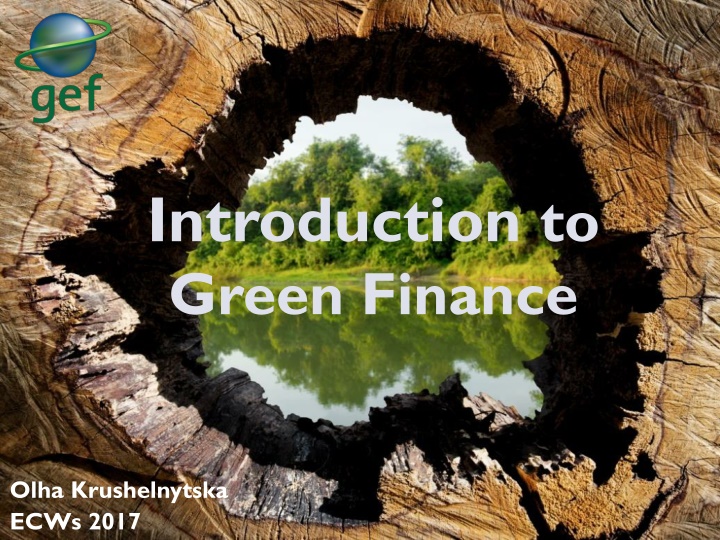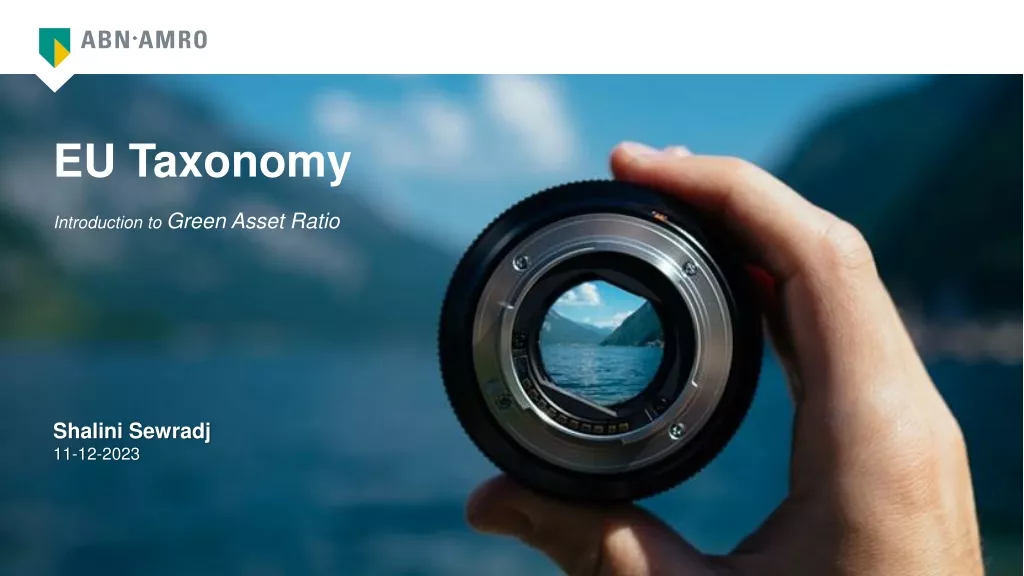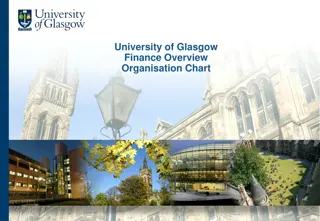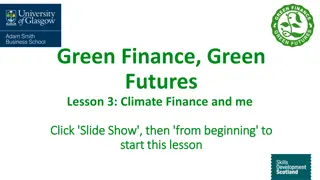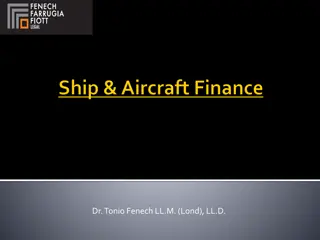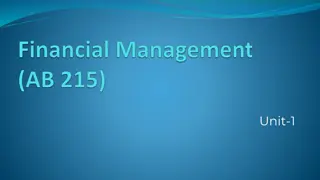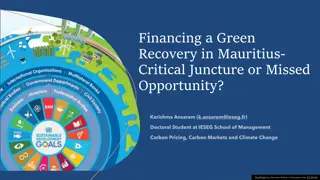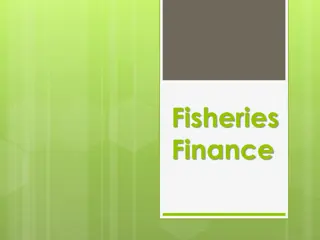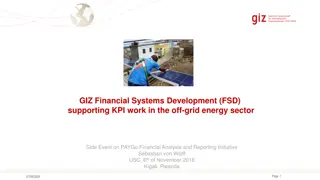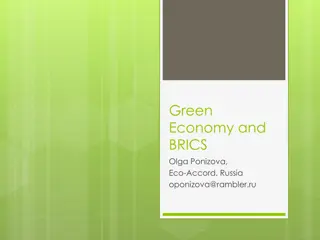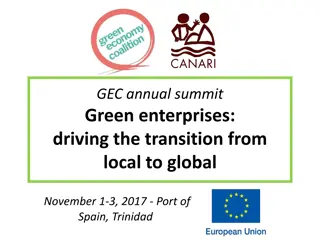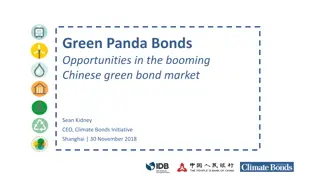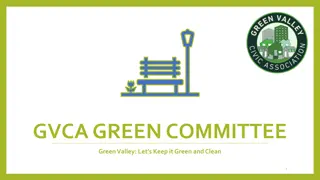Green Finance: Understanding Financial Solutions for Sustainable Projects
Explore the world of green finance, focusing on the use of financial products and services to support eco-friendly projects beyond just climate finance. Learn about the need for additional finance in various sectors like conservation, energy, and renewables. Discover the main financial instruments used in conservation, how to leverage private sector capital, and why understanding private finance is crucial for developing socially beneficial and sustainable projects. Delve into the brief history of green finance and how financial innovations are transforming the way capital is raised for conservation efforts.
Uploaded on Sep 07, 2024 | 4 Views
Download Presentation

Please find below an Image/Link to download the presentation.
The content on the website is provided AS IS for your information and personal use only. It may not be sold, licensed, or shared on other websites without obtaining consent from the author.If you encounter any issues during the download, it is possible that the publisher has removed the file from their server.
You are allowed to download the files provided on this website for personal or commercial use, subject to the condition that they are used lawfully. All files are the property of their respective owners.
The content on the website is provided AS IS for your information and personal use only. It may not be sold, licensed, or shared on other websites without obtaining consent from the author.
E N D
Presentation Transcript
Introduction to Green Finance Olha Krushelnytska ECWs 2017
GREEN FINANCE: DEFINITION Use of financial products and services, such as loans, insurance, stocks, private equity & bonds in green (or eco-friendly) projects Green finance is more than climate finance, but includes land, forests, water, oceans, conservation, resilience--indeed every type of GEF investment Introduction to Green Finance brochure - goo.gl/VzoRVF
NEED FOR ADDITIONAL FINANCE Annual funding needed: Conservation $400-600 billion (spent only $50-62 billion) $300-$400b gap = 1% of private sector investments Public $ can cover less than 15% Energy Access - $45 billion (spent $9 billion) Renewables - $320 billion (spent $154 billion) Efficiency - $390 billion (spent $225 billion) Additional finance (gap) - $350 billion Climate $392 invested in 2014 (>60% private$) - still falling short $250 billion
SESSION OVERVIEW 1. Main financial instruments in conservation Debt / Equity / Guarantees 2. Leveraging private sector capital 3. Cases Forestry fund Fisheries fund Energy efficiency program Audience: professionals entering Green Finance space
WHY THIS SESSION? Private capital - the biggest part of conservation/climate funding To access private finance, we need to know how it works Finance can be explained in simple terms We can apply this knowledge to answer the following: How do we develop socially beneficial projects which attract private finance? How do we make the project sustainable long term (after the funding is over)? How do we prioritize our work program to attract more capital?
GREEN FINANCE: BRIEF HISTORY Investment in conservation evolved: 19th century: simple public sector financing (taxes, fees, stamps and government spending) 20th century: mix of public & philanthropic finance Last 25 years: growing involvement of the private sector + the development of new financial mechanisms E.g. we can use tropical forest assets to generate revenues from operations in fields of sustainable timber, agriculture and ecotourism Financial innovations: social policy bonds, crowdsourcing initiatives (online platforms to mobilize capital) will transform raising capital
GREEN FINANCE: ASSET CLASSES Asset class - group of financial instruments: with similar characteristics, that behaves similarly in the marketplace, and subject to the same laws/regulations 2 Asset classes / financial instruments commonly used in green finance: (1)Equity(Stocks) (2)DebtFixed Income) + risk management tool: Guarantees
BLENDED FINANCE HOW IT WORKS PRIVATE Investor Can Invest $8m Required return 7% Fund / Project Projects an generate 6% Project / Company 3 Project / Company 2 Project / Company 1 To simplify calculations, we assume projects last only 1 year
BLENDED FINANCE HOW IT WORKS Invested $2m PRIVATE Investor PUBLIC Investor (GEF) Invested $8m Required return 2% Required return 7% Total Invested $10m Fund Project / Company 1 Project / Company 2 Project / Company 3 Projects an generate 6% To simplify calculations, we assume projects last only 1 year
BLENDED FINANCE HOW IT WORKS Invested $2m PRIVATE Investor PUBLIC Investor (GEF) Invested $8m Required return 2% Required return 7% Total Invested $10m Fund Project / Company 1 Project / Company 2 Project / Company 3 Total generated $10.6m - 6% Projects an generate 6% To simplify calculations, we assume projects last only 1 year
BLENDED FINANCE HOW IT WORKS Invested $2m PRIVATE Investor PUBLIC Investor (GEF) Invested $8m Required return 2% Required return 7% Total Invested $10m Fund Total generated $10.6m - 6% $2.04m - GEF $8.56m - Private Project / Company 1 Project / Company 2 Project / Company 3 Projects an generate 6% To simplify calculations, we assume projects last only 1 year
BLENDED FINANCE HOW IT WORKS Invested $2m Invested $8m PRIVATE Investor PUBLIC Investor (GEF) Required return 2% Required return 7% 8x1.07=$8.56m Total Invested $10m Fund Total generated $10.6m - 6% $2.04m - GEF $8.56m - Private Projects an generate 6% Project / Company 1 Project / Company 2 Project / Company 3 To simplify calculations, we assume projects last only 1 year
EQUITY FINANCING Equity - ownership in the business Common shares (junior equity) vs Preferred shares - Junior shares are subordinated to preferred shares - Liquidation: preferred stockholders paid first - Dividends: different/greater for preferred shares Public institutions often invest in junior equity absorbs risks of first losses (but perhaps also seeks risk-adjusted returns); Private investors invest in preferred shares (senior shares) Private Investors, DFIs, IFIs Senior/Preferred Shares, Senior Debt Public Donors, GEF Junior Shares, Grants
EQUITY IN GEF PROJECTS Objective: Supporting small-scale clean energy projects to reduce CO2 Input: GEF invested $4.5m in junior equity of Africa Renewable Energy Fund (AREF) with capped return of 4% African Development Bank (AfDB) and other Donors provided $25m Co-financing of at least $150m Process and Output: AfDB manages AREF AREF invests in clean energy projects GEF capped return enables returns to other investors to increase by 2-3% Number of projects to be developed (currently 18 at project initiation) Impact: reduction of 3.8 million tons CO2 during the project life (10 years)
DEBT FINANCING Notes, bonds, loans, debentures, certificates, mortgages, leases & other agreements Loan: $ from a bank to a company, with interest payment, over specific time collateral to guarantee repayment (if difficult equity preferred) Bond: $ from the public market to a company trade on public market and involve larger amounts (typically min $100m) Seniority Senior debt: greater security (lower risk) & lower interest payment Debt is senior to Equity - creditors are paid before shareholders Private Investors Senior Debt (Senior Notes, Loans) Subordinated Debt (Subordinated Notes, Loans) Public Donors, GEF
DEBT IN GEF PROJECTS Objective: Improving freight transport efficiency to reduce GHG emissions in the Black Sea Region Input: GEF provided $16.4m in subordinated debt (junior funding) Co-financing: $155m during, and $250m after project completion Process and Output: EBRD manages The Green Logistics Program (ongoing) GEF investment in subordinated debt reduces the cost of project financing (reduces required interest rates) enabling EBRD investment Impact: estimatedGHG reduction by 9.1 million tons CO2e
GUARANTEES Reduce the probability of default Support the flow of private investments - in projects where investors and lenders are seeking to mitigate risk Credit guarantee covers non payment by private borrowers. Full or partial guarantee. Partial guarantee up toa predetermined amount Performance guarantee - agreement between a client and a contractor for the contractor to perform all of their obligations under the contract
GUARANTEES IN GEF PROJECTS Objective: Supporting land restoration in Latin America Input: GEF invested $15m in guarantees and subordinated loans Co-financing $120m by Inter-American Development Bank and others Process and Output: Private sector interested in restoration of degraded lands. These investments have long payback periods & high financial risk GEF reduces risk enables private investments + public investmt (IADB) Activities: landscape regeneration; intercropping; shade-grown systems for coffee and cocoa; timber and non-timber product; improving soil, water and temperature regulation by improving agric. land management Impact: restoration min 45,000 ha, emissions reductions 4.5m tCO2e
Example of Blended Capital Structure Source of Capital: Structure No. 1: Structure No. 2: Private Investors Debt (Notes) Senior Debt (Senior Notes, Loans) DFIs, IFIs Senior Shares Subordinated Debt (Subordinated Notes, Loans) DFIs, IFIs Mezzanine Shares (Hybrid of Debt & Equity) Senior Shares Public Donors Junior Shares Junior Shares Guarantee Grant
BARRIERS FOR PRIVATE CAPITAL High search costs - attractive risk returns, sufficient and predictable cash flows, bigger projects Lack of track record of projects and developers Monitoring of conservation impact Scalability/replicability for future projects
SO WHATS NOW? New types of collaboration btw investors, NGOs /project developers & public entities Blending of non-concessionary and concessionary capital Addressing the barriers within the GEF framework: How do we develop socially beneficial projects which attract private finance? How do we make the project sustainable long term (after the funding is over)? How do we prioritize our work program to attract more capital GEF-led Green Finance Community of Practice site coming soon
CASE 1: FORESTRY FUND Investors (GEF and others) Forestry Fund Forestry projects/businesses (1) Forestry companies need capital. But private sector investors reluctant to invest due to: long payback periods, lack of track record and uncertainty over product prices. (2) The Fund will provide long-term (debt / equity) funding to 5-6 existing projects to scale them up, so they can further attract (debt / equity) financing from financial institutions (3) The GEF has taken a (lower return & higher risk / higher return & lower risk)position in the fund, which helps lower risks for private sector investors (4) The interests of private sector (debt / equity) investors are closely aligned with those of the other shareholders: they want to add value by ensuring effective governance and high environmental & social standards of funded companies.
CASE 1: FORESTRY FUND (1/4) (1) Forestry companies need capital. But private sector investors reluctant to invest due to: long payback periods, lack of track record and uncertainty over product prices.
CASE 1: FORESTRY FUND (2/4) (2) GEF helps establish the Forestry Fund, which will provide long-term (debt / equity) funding to 5-6 existing projects to scale them up, so they can further attract (debt / equity) financing from financial institutions.
CASE 1: FORESTRY FUND (3/4) (3) The GEF has taken a (lower return & higher risk / higher return & lower risk)position in the fund, which attracts private sector investors.
CASE 1: FORESTRY FUND (4/4) (4) The interests of private sector (debt / equity) investors are closely aligned with those of the other shareholders: they want to add value by ensuring effective governance environmental & social standards of funded companies. and high
CASE 1: FORESTRY FUND ANSWERS Investors (GEF and others) Forestry Fund Forestry companies (1) Forestry companies need capital. But private sector investors reluctant to invest due to: long payback periods, lack of track record and uncertainty over product prices. (2) The Fund will provide long-term equity funding to 5-6 existing projects to scale them up, so they can further attract debt financing from financial institutions (3) The GEF has taken a lower return/higher riskposition in the fund, which helps lower risks for private sector investors (4) The interests of private sector equity investors are closely aligned with those of the other shareholders: they want to add value by ensuring effective governance and high environmental & social standards of funded companies.
CASE 2: FISHERIES FUND (1) Fund for sustainable small-scale fisheries will be one of the very few financial institutions providing long term financing in community fisheries. (2) Fund Will provide long-term (debt / equity / debt and equity) investments to promising enterprises operating in the sustainable wild-caught seafood and mariculture sectors. Capital to be used for the acquisition of fixed assets by borrowers. (3) GEF invests in (stocks / loans) of 5-7 years and expects to earn 10-15% return.
CASE 2: FISHERIES FUND (1/3) (1) Fund for sustainable small- scale fisheries will be one of the very few financial providing long term financing in community fisheries. institutions
CASE 2: FISHERIES FUND (2/3) (2) Fund will provide long-term (debt / equity / debt and equity) investments to promising enterprises operating in the sustainable seafood sector. Capital used for the acquisition of fixed assets by borrowers.
CASE 2: FISHERIES FUND (3/3) (3) GEF invests in (stocks / loans) of 5-7 years and expects to earn 10-15% return.
CASE 2: FISHERIES FUND ANSWERS (1) Fund for sustainable small-scale fisheries will be one of the very few financial institutions providing long term financing in community fisheries. (2) Fund will provide long-term debt and equity investments to promising enterprises operating in the sustainable seafood sector. Capital to be used for the acquisition of fixed assets. (3) GEF invests in loans of 5-7 years and expects to earn 10-15% return.
CASE 3: ENERGY EFFICIENCY PROGRAM (1) Energy Service Companies (ESCOs) - private enterprises that implement improvements to reduce energy consumptions. Require lending for equipment and process improvements. However they lack access to (commercial credit / capital markets). (2) The banks conventionally lend against high levels of (fixed asset collateral / guarantees from other financial institutions). ESCOs often cannot meet these requirements. (3) The project objective is to develop energy efficiency industry, through (risk sharing / co- investing) with commercial lenders. (4) GEF funds will be used to create a (performance risk guarantee / credit enhancement guarantee) program. The program includes creation of the Risk Facility. (5) The Risk Facility will be used to share the risk with commercial banks. Its funds would be paid out to participating banks in the event of a loss or default - partial coverage of banks risk exposure. Thereby ESCOs can obtain a bank debt with a (lower / higher) cost and a (shorter / longer) term. Banks Final 10% Loss: Banks Risk Facility Banks Next 80% Loss: Shared equally between Risk Facility and banks Risk Facility First 10% Loss: Risk Facility
CASE 3: ENERGY EFFICIENCY PROGRAM (1/5) (1) Energy Service Companies (ESCOs) - private enterprises that implement improvements to reduce energy consumptions. Require lending for equipment and process improvements. However they lack access to (commercial credit / capital markets).
CASE 3: ENERGY EFFICIENCY PROGRAM (2/5) (2) The banks conventionally lend against high levels of (fixed asset collateral / guarantees from other financial institutions). ESCOs often cannot meet these requirements.
CASE 3: ENERGY EFFICIENCY PROGRAM (3/5) (3) The project objective is to develop energy efficiency industry, through (risk sharing / co-investing) with commercial lenders.
CASE 3: ENERGY EFFICIENCY PROGRAM (4/5) (4) GEF funds will be used to create a (performance risk guarantee / credit enhancement guarantee) program. The program includes creation of the Risk Facility.
CASE 3: ENERGY EFFICIENCY PROGRAM (5/5) (5) The Risk Facility will be used to share the risk with commercial banks. Its funds would be paid out to participating banks in the event of a loss or default - partial coverage of banks risk exposure. Banks Final 10% Loss: Banks Risk Facility Banks Next 80% Loss: Shared equally between Risk Facility and banks First 10% Loss: Risk Facility Risk Facility Thereby ESCOs can obtain a bank debt with a (lower / higher) cost and a (shorter / longer) term.
CASE 3: ENERGY EFFICIENCY ANSWERS (1) Energy Service Companies (ESCOs) - private enterprises that implement improvements to reduce energy consumptions. Require lending for equipment and process improvements. However they lack access to commercial credit. (2) The banks conventionally lend against high levels of fixed asset collateral. ESCOs often cannot meet these requirements. (3) The project objective is to develop energy efficiency industry, through risk sharing with commercial lenders. (4) GEF funds will be used to create a credit enhancement guarantee program. The program includes creation of the Risk Facility. (5) The Risk Facility will be used to share the risk with commercial banks. Its funds would be paid out to participating banks in the event of a loss or default - partial coverage of banks risk exposure. Thereby ESCOs can obtain a bank debt with a lower cost and a longer term.
Thank you! QUESTIONS? Brochure: goo.gl/VzoRVF
